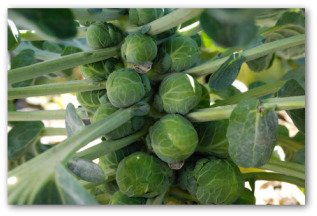Growing Brussel
Sprouts At Home

The best tips for growing Brussel sprouts when home vegetable gardening.
Learn how to plant, grow, care for, and harvest Brussels sprouts in a backyard vegetable garden for best results.
A member of the brassica family of vegetables, these high-yield, fast-growing vegetables are not only nutritious, but ornamental as well.
Design Your Own Vegetable Garden Layout Using our Free "Vegetable Garden Planner" Software!
Their cousins include broccoli, cabbage, turnip, kale, and the hardy mustard plant.
Growing Brussel Sprouts
In northern gardens, growing Brussel sprouts, (known as Brussels sprouts) begins in the last week of June.
Plant crops in the nursery bed where they will be protected but still benefit from fresh air and sunshine.
Sow the seeds one inch apart so they will not be crowded if they have to wait an extra week or two before setting them in the garden in July.

Download Free Garden Planning Worksheets, Garden Diary, Zone Chart, Or Planting Guide
Planting, Growing Brussel Sprouts
- Toward the middle of July, transplant growing Brussels sprouts seedlings to the garden bed.
- These plants will grow to 2 ½ - 3 feet high.
- Growing Brussels sprouts need well-drained soil rich in organic matter and full sun.
- The plants prefer heavy soil to light and sandy soil.
- The pH level should range from 6.0 to 6.8.
- Prepare the soil by adding lime if needed.
- Dig in 10-10-10 fertilizer and about 2 inches of compost into the soil to the depth of the spading fork.
Plant Spacing for Brussel Sprouts
Set the seedlings in at 18 inch intervals in rows 3 feet apart.
Eventually, the plants will need every bit of this space.
For now, there is room to inter-plant a few seedlings of bolt resistant lettuce in the rows of growing Brussels sprouts.

Starting Brussels Sprouts from Seeds
- In general, seeds take 5 to 10 days to germinate.
- Start transplants 6 to 8 weeks before setting out, which
can happen a month before to several weeks after the last expected
frost.
- Another way to calculate the seed starting date is to count back 120 days from first expected fall frost.
- Only gardeners with long growing seasons should sow seeds directly into the vegetable garden.
Brussel Sprout Varieties
Long Island Improved is ready for harvest in 90 days. High yields make this variety a favorite growing Brussels sprouts choice. The dark green sprouts resemble miniature cabbages when mature.
Jade Cross Hybrid also comes highly recommended by avid gardeners.
Brussel Sprouts Pests & Diseases
As a member of the cabbage family, growing Brussels sprouts are threatened by a variety of pests and diseases.
When you set the seedlings, give each plant a maggot mat.
Water the plants with a water and foliar fertilizer mix.
Young plants are bothered by cutworms, flea beetles, aphids, cabbage loopers, cabbage maggots, harlequin bugs, imported cabbage worms, and leaf miners.
Plant diseases to be on the lookout for are black rot, clubroot, downy mildew, and yellows.
Use careful plant rotations each year to avoid soil-borne disease problems.
Spray the foliage with insecticide at 7 to 10 day intervals to protect the growing Brussels sprouts from the imported cabbageworm caterpillar.
These precautions may be time consuming but they are well worth it to prevent the insects from getting the first bite out of your crops instead of you!
The plants snuggled safely in their beds will begin their long harvest season in September.

Harvesting Brussel Sprouts
- Growing Brussels sprouts are the sweetest after a good stiff frost.
- Although the first of your crop will be ready for picking before the first frost, many gardeners only harvest a few until the frosty fall weather sets in.
- Cut the larger bottom sprouts from the stem for a preview taste of the delicious little cabbages to come.
- Wait on harvesting the remaining sprouts until the ground freezes.
- Occasionally, Brussels sprouts are late producing with abundant foliage but produce no larger than marbles.
- If the sprouts do not begin to grow by mid-September, pinch out the tip of the plant.
- This action stops the plant's vertical growth and encourages the energy to go laterally to produce fat sprouts along the stem.
Back To Top
Growing Brussel Sprouts to Vegetable Gardening

